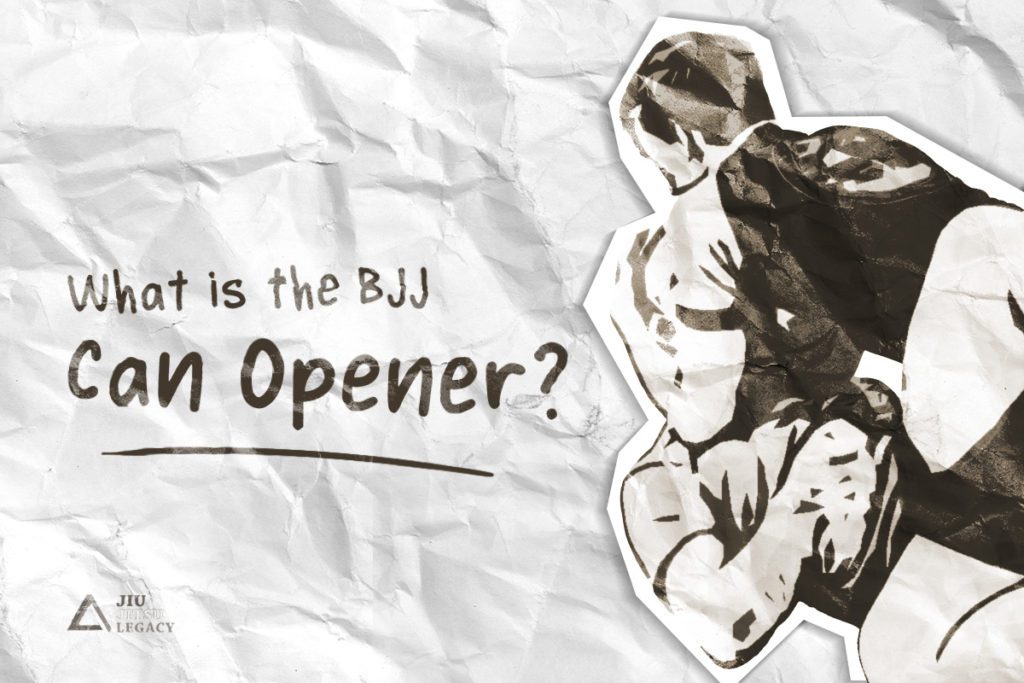The can opener is one of those no-no submissions that you’re told to never use in BJJ training. But the technique is one you should learn, as well as how to defend.
Here is how to attack and defend and attack against the BJJ can opener. We’ll detail everything that you need to know about the move and why it’s banned within most grappling federations.
What is the Can Opener in BJJ?

In grappling, the BJJ can opener is a submission technique that is typically applied from the guard position. It involves gripping your opponent’s collar/head with both hands and then pulling their head towards you while simultaneously pushing their body away with your legs
Creating a “lever” effect that puts pressure on their neck and spine. The can opener is often used as a way to open up an opponent’s guard, by forcing them to release their leg grip on your waist or hips.
However, if executed with enough force, the can opener can also be used to submit an opponent by causing them to tap out due to pain or discomfort in their neck and spine.
Mark Coleman
One of the most famous uses of the can opener submission was by MMA legend Mark “the hammer” Coleman. The former UFC champion successfully used the submission at the 2000 Pride Grand Prix.
Submitting opponent Masaaki Satake at 1:14 of the first round. Coleman was also known for using the can opener submission to set up his patented ground and pound within closed guard.
How The BJJ Can Opener Got Banned?
The BJJ can opener has been banned for years, but many don’t know how it got banned. How the can opener got banned in most federations was due to a match between Jeff Monson and Marcio Cruz.
Monson and Pe de Pano competed against each other at the Arnold Gracie Competition in 2004. The rules of the competition stated that the can opener could be used to open an opponent’s guard. But the technique was prohibited as a submission.
During their match, Jeff put on the submission and Cruz tapped out and complained to the ref. After twenty minutes of arguing, the ref disqualified Monson and awarded Cruz the win. This resulted in a melee, where Monson had to be held back from assaulting the ref.
Both competitors would get banned for a year from competing at the event. It also made BJJ federations take action and ban the can opener completely.
Now, the only place the BJJ can opener is permitted is within ADCC and NAGA advanced divisions.
How and When to Use the BJJ Can Opener?
The can opener submission is pretty straightforward to learn. Here is how and when to use the BJJ can opener.
How to Use the BJJ Can Opener?
The can opener is probably the easiest technique to administer within grappling. When you’re in your opponent’s guard, there’s just two steps to lock on the submission.
Clinch behind your opponent’s head with both hands (the same as a Thai clinch). They pull their head to their chest and put immense pressure on their cervical spine. That’s the simplest breakdown we can give on the technique.
When to Use the BJJ Can Opener?
When to use the BJJ can opener is a little tricky. You should never try to damage your training partner’s neck and use it as a submission.
But you use it (WITH CAUTION!) to force them to open their closed guard. They may not like you after the roll, but using this technique will make them open their guard.
The BJJ Can Opener in the Gi
The BJJ can opener is predominantly used in no-gi, but can be done in the Gi. Instead of grabbing your opponent’s head, you’re going to grab their collar with both hands if you’re stuck in closed guard.
You can either try pulling their collar to force them to open their guard or do a technical standup. After you stand up, take one hand off their collar and pull their leg down to open their guard.
Just like the no-gi version, the gi version is not a nice move and your partner may not be your friend afterward.
Defending the BJJ Can Opener Neck Crank
The BJJ can opener is rather easy to defend against. Try one of these four options to defend against the technique.
Control Opponent’s Arms
The first rule of playing guard or BJJ in general is that you never let your opponent control your head. In guard, you should always be controlling your opponent’s arms. If you get sleeve grips, overhooks, or just palm your opponent’s biceps, the can opener won’t be a threat.
Arm Bar/ Double Arm Bar
When your opponent goes for a can opener, they’re actually breaking a big rule of grappling by extending their arms. By doing this, they’re giving you your choice of an arm bar or double arm bar. Once you arm bar them, they’ll never try the can opener again.
Stuff Opponent’s Head
If your opponent does clinch your head and attempt the can opener, you can counter by re-grabbing their head. Palm the back of their head with both hands and push their head to their chest. This will either put enough pressure on their neck, where they let go, or give you space to hip escape away.
Hands On Floor and Hip Escape
Another counter that you can try is to put your hands on the floor and hip escape. Once your opponent grabs your head, put your hands on the floor and scoot away. Your opponent has the space to go for something else, but you take away the threat of the BJJ can opener. Check out Stephan Kesting from GrappleArts explain how to use these defenses.
Is the Can Opener Effective?
Let’s be honest about the can opener neck crank. If you’ve been training for at least six months, you should never get caught in this neck crank.
You will never see a high level grappler in BJJ or MMA get caught in this submission. Only beginners get caught in this technique, and once you drill the defenses, you’ll never get caught again.
Closing Thoughts
It’s important to note that the can opener can be a controversial technique in grappling, as it can put significant pressure on the cervical spine and has the potential to cause serious injury if applied too aggressively or with excessive force.
As with all submission techniques, it should be used with caution and only in a controlled, supervised training environment. So, you should definitely know how to use and defend the BJJ can opener, but be careful. It can definitely injure your opponent and put them on the shelf.

